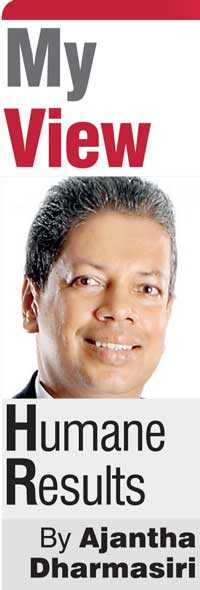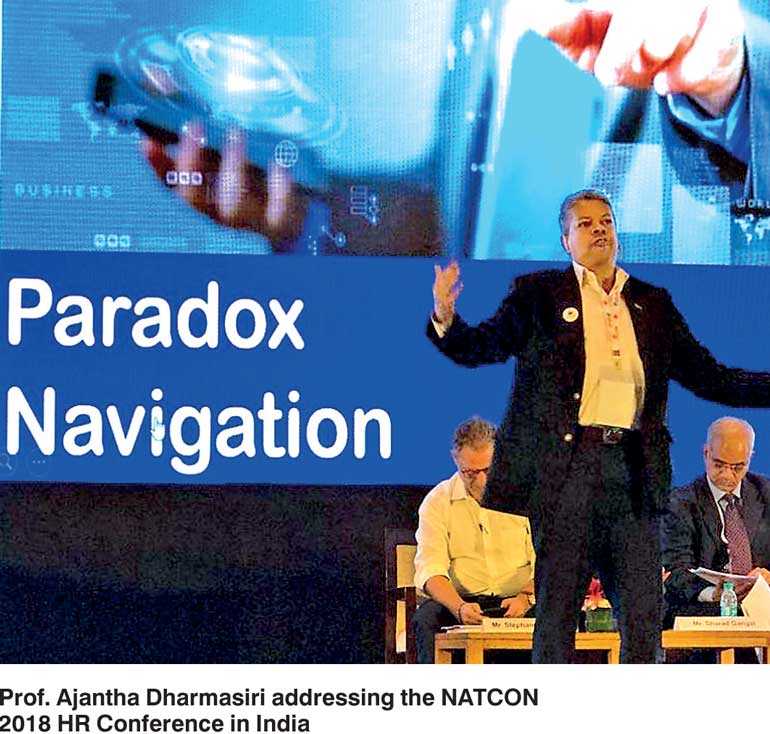Sunday Apr 20, 2025
Sunday Apr 20, 2025
Monday, 8 October 2018 00:00 - - {{hitsCtrl.values.hits}}
It was delightful to be a Sri Lankan speaker at the NATCON 2018, the biggest HR conference in India held in Pune recently. I spoke on the future of HR and had the opportunity to discuss it further with Dr. T.V. Rao, who is hailed as the pioneer of the HR development in India.
Being a part of a ‘humanly rich’ region, there are many commonalities with regards to managing and motivating people. Today’s column is a reflection of rethinking of HR as ‘paradox navigation’.
Overview
The typical dictionary meaning of paradox is that it is “a seemingly absurd or contradictory statement or proposition which when investigated may prove to be well founded or true.” Navigation on the other hand means “the process or activity of accurately ascertaining one’s position and planning and following a route”. This is the acute need in front of HR professionals. As Prof. Ulrich from Michigan University explains, “navigating paradox means accepting, exploring, and dealing with the inevitable tensions in a business. They have to help  the business to be both short and long term, top/down and bottom/up, global and local, divergent and convergent, strategic and operational, etc. By navigating these paradoxes, organisations are more able to respond to the demands of change in today’s business context.”
the business to be both short and long term, top/down and bottom/up, global and local, divergent and convergent, strategic and operational, etc. By navigating these paradoxes, organisations are more able to respond to the demands of change in today’s business context.”
In essence, “paradox navigation” is the ability to steer amidst the many embedded tensions in complex organisational operations. We can raise a few vital questions here. Does the HR professional effectively manage the tensions between high-level strategic issues and operational details? Does he/she effectively manage the tensions between internal focus on employees and external focus on customers and investors? Does he/she effectively manage the tension between taking time to gather information and making timely decisions? Does he/she effectively manage the tensions between global and local business demands? Does he/she effectively manage the tensions between the need for change (flexibility, adaptability) and stability (standardisation)?
The reality is that the HR professionals are constantly wrestling with embedded tensions that must be resolved in some circumstances and cultivated in other circumstances in order to help the business move forward. Wisely navigating through these surrounded strains becomes one of the central challenges for modern HR professionals.
Paradox navigation makes East and West meet
In digging deeper, I see a parallel between paradox navigation by western HR researchers and the Yin-Yang concept of eastern wisdom. In simple terms, yin is characterised as slow, soft, yielding, diffuse, cold, wet, and passive; and is associated with water, earth, the moon, femininity and night-time. Yang, by contrast, is fast, hard, solid, focused, hot, dry, and aggressive; and is associated with fire, sky, the sun, masculinity and daytime.
To put even more precisely, yin and yang are complementary opposites that interact within a greater whole, as part of a dynamic system. Everything has both yin and yang aspects, but either of these aspects may manifest more strongly in particular objects, and may ebb or flow over time. This is the nature of HRM in reality, where managing employee concerns as well as employer concerns need to take place with synergy and harmony.
In other words, showcasing paradox navigation is one way of accepting the eastern duality. This is very much pertinent in the context of change where we are increasingly moving into a Volatile, Uncertain, Complex and Ambiguous (VUCA) World. Paradox navigation can in fact move beyond HR. In practical sense, every manager has to do so in some way or the other. In other words, it is challenge of balancing the harmony between yin and yang.
Moving from HRM to HPM
In navigating the paradox of managing people, a conceptual clarity is required with regards to the use of the word “resource” in identifying people. I came across this very interesting argument by Prof. Satish Kalra of Management Development Institute (MDI), India.
According to him, treating human beings as a resource to be used, utilised or manipulated like any other resource is demeaning. Further, with the increasing number of highly skilled knowledge workers, resentment of the word “resource” is likely to increase, since knowledge workers are inclined to be hostile to manipulation. They would prefer the organisation to enable them to fulfil their true potential and, in so doing, help the organisation to achieve its objectives.
Prof. Kalra refers to the dictionary meaning of the term “potential” as “capable of coming into being or action”. “Human beings by nature are full of energy, capable of thinking and equipped with superior mental abilities; therefore, they are capable of being proactive as opposed to being reactive; their latent energies can “come into being”. In fact, the dictionary definition of potential also considers latent energy. “By using their potential, human beings are capable of taking charge of themselves. They need not be directed by external influences”, observes Prof. Kalra.
“With the increase in the number of knowledge workers, employees today would most likely be inclined to develop and exploit their own potential unconditionally”. This is reinforced by the results of many studies. The findings of one such study done in India, indicate that the biggest motivational factor for knowledge workers is “personal growth” followed by “operational autonomy” and then by “task achievement”. Among the four major motivators, money was the least motivational factor. Personal growth is referred to as “the opportunity for individuals to realise their potential”, and operational autonomy is defined as “a work environment in which
knowledge workers can achieve the tasks assigned to them within the constraints of strategic direction and self-measurement indices”. In fact, “successful companies in time to come will be those which can motivate employees to use their full talents for the firm”, observes Prof. Karla.

HPM defined
I remember a veteran trade unionist vehemently opposing the use of term “human resources
as opposed to “human beings”. HPM definition offered by Prof. Satish Karla might be a consolation for him.
“Human potential management is an integrative and continuous process of enhancing human capabilities and capacities by enriching human beings’ existing potential and helping them to discover and tap their latent potential through micro-level human development interventions and macro-level systems and policy interventions to create and sustain an environment.”
As Prof. Kalra highlights, HPM has an underlying belief that if human beings are provided with opportunities to use their potential, they can manage themselves. This in a way is contrary to the belief system underlying HRM which says that human beings have to be managed (utilised/used) to achieve organisational objectives. He further differentiates HPM from HRM in several ways:
From potential to possibilities
Despite the wide popular use of HRM, the focus on human potential offers much prospects in unleashing the “people power”. As Prof. Jagdish Paarikh in his seminal book, ‘Beyond Leadership’ highlights, such “people power” is manifested in obvious features of a human being.
Our eyes can discriminate eight million shades and our ears can discriminate 300,000 tones. We are blessed with a super-computer brain with immense observing, recording, analysing, recalling and strong capacity equivalent to thousands of contemporary mainframes. Beyond computing, it has almost immeasurable learning, understanding-imaging, creative, and intuitive abilities. The challenge is to use the human potential for the progress individuals as well as institutions.
Possibilities are immense when the unleashing of human potential systematically takes place. Imagination leading to innovation becomes inevitable. High-tech and high-touch harmony will also be possible with proper “paradox navigation”. With digital disruptions taking place, the demand for human creativity will be on the rise.
Relevance to Sri Lanka
The above discussion should not be a fantasy for us Sri Lankans. When we see many of our brilliant talent excel as expatriates, unleashing of human potential at least in overseas is visible. What barriers prevent us doing so in Sri Lanka?
The choice of connections over the competencies has been a perennial issue in the local political arena. There are many instances when kith and kin of those who are at the helm appeared to be the favourites, with regard to filling the key positions. A strategic approach with a holistic perspective is required to have “paradox navigation” in ensuring proper “human potential management”.
“One worthwhile task carried to a successful conclusion is worth half-a-hundred half-finished tasks” – so said Malcolm S. Forbes. What we require is clarity on strategy on one hand and the consistent continuity of execution on the other hand. People factor with proper leadership in action is key for such an endeavour.
Discover Kapruka, the leading online shopping platform in Sri Lanka, where you can conveniently send Gifts and Flowers to your loved ones for any event including Valentine ’s Day. Explore a wide range of popular Shopping Categories on Kapruka, including Toys, Groceries, Electronics, Birthday Cakes, Fruits, Chocolates, Flower Bouquets, Clothing, Watches, Lingerie, Gift Sets and Jewellery. Also if you’re interested in selling with Kapruka, Partner Central by Kapruka is the best solution to start with. Moreover, through Kapruka Global Shop, you can also enjoy the convenience of purchasing products from renowned platforms like Amazon and eBay and have them delivered to Sri Lanka.
Discover Kapruka, the leading online shopping platform in Sri Lanka, where you can conveniently send Gifts and Flowers to your loved ones for any event including Valentine ’s Day. Explore a wide range of popular Shopping Categories on Kapruka, including Toys, Groceries, Electronics, Birthday Cakes, Fruits, Chocolates, Flower Bouquets, Clothing, Watches, Lingerie, Gift Sets and Jewellery. Also if you’re interested in selling with Kapruka, Partner Central by Kapruka is the best solution to start with. Moreover, through Kapruka Global Shop, you can also enjoy the convenience of purchasing products from renowned platforms like Amazon and eBay and have them delivered to Sri Lanka.